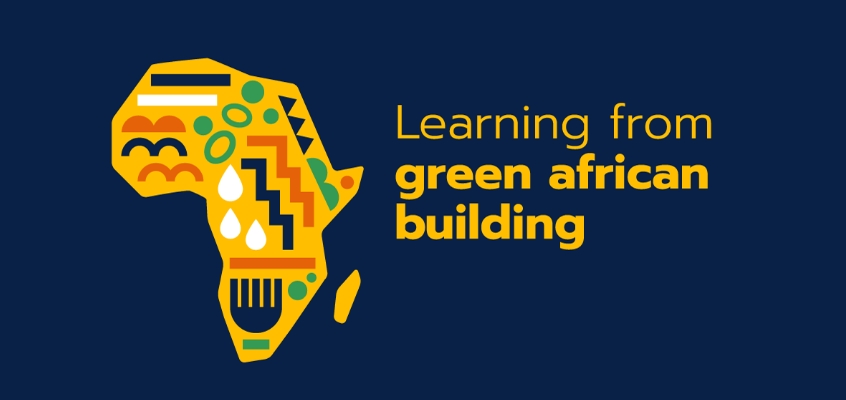By 2050, Africa is expected to have 2.5 billion inhabitants versus 1.2 billion today[1]. The continent is facing a major housing crisis.[1]. L’Afrique fait face à une crise du logement majeure.
In the current ecological context, discussions on scaling up to mass produce housing are insufficient. We must shift paradigm to adopt a stance that questions the implementation of sustainable processes in the production of decent housing for all. To be sustainable, this process must be designed from an understanding of the methods and needs of the local ecosystem.
Yet, according to a 2015 World Bank study, “the informal building materials and construction sector dominates home construction. Most homes are self‐built or built by informal contractors using inexpensive traditional materials”[2]. The same study asserts that formal housing is financially inaccessible for most households in Sub- Saharan Africa.
Considering the place of traditional materials in the construction sector, we can ask ourselves: whether desirable and sustainable architecture can be built using traditional materials today.«
And more generally, what architecture do we want in the future, independently of location? Ideally, architecture should be qualitative and resilient, sustainably providing socio-economic benefits at the local level, respectful of the environment and local cultures and for the greatest number of people.
African heritage and recent developments for a more sustainable architecture promoting geomaterials and bio-based materials show us that this ideal is not so far away and may be accessible.
Qualitative architecture: vernacular structures
Earth architecture now accounts for 203 sites on the UNESCO World Heritage List. Due to their longevity, this heritage – some of which are hundreds of years old – attests to the durability of this kind of architecture. They demonstrate African artistic, architectural, technical and urban planning genius. The international community have also recognised the ability of these structures to integrate harmoniously with the environment, as illustrated by cultural landscapes, such as the Bassari cultural landscape in Senegal. These structures genuinely bind society together, as demonstrated by the community investment in the annual plastering of the Djenné mosque.
With regard to the capacity of these vernacular structures to support resilience, they all have their place when we recognise that they were built in the first place because of the strengths of their designs and their use of locally available resources. In addition, African construction traditions abound in age-old know-how that responds to natural hazards. Previous generations have learned to understand and manage these hazards via construction techniques, legends, taboos and regulations. These lessons are worth documenting. They could be reverse engineered, offering opportunities to improve their resilience capacities.
Contemporary earth architecture is now presented in a resolutely contemporary light and is part of a sustainable approach. Francis Kéré’s primary school in Gando, Burkina Faso, built in 2004, attests to the performance of earth structures. It demonstrates the architectural quality and the benefit of bioclimatic design through the internal temperature, among other things. Driven by Kéré’s enthusiasm and international trends, many contemporary earth structures are appearing in Africa, as shown by the results of the FACT Sahel+ international earth architecture competition[3].
The innovation capacity of techniques and structures is often considered an indicator of performance. Recent research shows that local materials are innovating and rising to challenges, such as those caused by climate change. Research by the Ministry of Environment in Senegal and the UNDP, with the expertise of CRAterre, led to the development of a highly insulating building material that combines earth and the invasive typha plant (2014–2016).
Environmentally respectful architecture: structures made of local materials
Fortunately, Africa’s contribution to emissions is still low. However, an environmentally conscious approach must be introduced to stop Africa from falling into patterns that have proven catastrophic for the planet. In Africa, the sector’s emissions are mainly linked to imports and the production of carbon-intensive materials (concrete, steel and fired bricks). To reduce these emissions, we urgently need to boost the development of a more local building economy and to only use concrete, sand and fired bricks where strictly needed.
Africa is full of natural resources, making a wide range of building techniques and architectural responses possible. However, it is essential to ensure the regeneration of resources and the introduction of sustainable and conscious supply conditions at a regional scale.History, especially customs, teaches us that ad-hoc architectural responses, carried out with respect for nature according to the available resources, have a minimal environmental impact. It also teaches us that cultural diversity and the expression of identity diversity result in a variety of structures, reducing pressure on ecosystems. To this end, a regional approach, bringing together government players, is vital for sound resource management, regulation of extracted quantities and resource renewal. Upscaling to meet the massive housing need should not therefore aim for standardisation but rather diversification and localisation.
Socioeconomic benefits: a real challenge for Africa?
According to the World Bank, in Burundi, 70% of homes are built with adobe brick, and in Malawi, 66% of people live in traditional housing[4]Additionally, UN-Habitat indicates that the self-build model “is perhaps the only housing approach common to all African countries that is affordable at the household level”.[5] Today, self-builds and the use of traditional materials are criticised. Despite this, they respond to a vital need and trigger a gradual improvement in homes.
Although it is still too informal, the traditional materials construction sector is a living economic ecosystem that would be viable if better structured and trained. We must support the establishment of formally qualified construction companies using traditional materials. When material production is structured at the craftsperson or semi-industrial scale, as is mainly the case, using local materials offers enormous potential for skilled and unskilled job creation. What’s more, these jobs cannot be relocated and cover the entire production-construction-maintenance chain. The use of local materials has the potential to sustainably anchor capital and investment in the region, reduce vulnerabilities to shocks and overcome global economic variability.
Unfortunately, traditional materials are sometimes now more expensive than imported materials. However, this partial view obscures our ability to design a long- term economy. Constructions using traditional materials have higher costs for a variety of reasons, including scarce labour, investment in machinery to the detriment of investment in people and a multitude of administrative obstacles that require a lot of time and motivation to overcome.
Wouldn’t it be sensible to invest in our human capital of many workers and craftspeople now? This could be achieved by developing technical and vocational teaching and a way to recognise professional skills. Certainly, this upskilling requires a lot of investment. But these strategies are a means to develop know-how, providing added economic value and dignity in work, especially to craftspeople, who are key players in the sector.
Today, the construction sector in Africa is limited to a few large foreign companies and thousands of small businesses and individual craftspeople who carry out smaller projects. To upscale housing production, should the latter not aim to structure themselves, group together and strengthen each other in what they know how to do: localised expertise using local resources?
Conclusion: For everybody
The COVID-19 pandemic emphasised the finite nature of dependency and the benefit of reducing the use of imported materials and developing short production chains. In the current economic fabric, earth may, like other local materials, provide an appropriate response to the housing need.
Localised construction is proven and at our fingertips. There are earth structures that are several hundred years old in the majority of African countries, while the use of concrete scarcely dates back two hundred years old. In addition, Africa is full of a wide range of renewable and accessible materials, provided they are appropriately managed.
Structures made of traditional materials are criticised but accessible to all. They are the reality for many residents, represent a non-negligible local economy and can be very high quality. Reinvigorated by strengthened skills, art and know-how, as before the industrial age, these structures made using local intelligence may valuably meet the need for sustainable architecture.
[1] Afrique : la population devrait doubler d’ici 2050, quadrupler d’ici 2100 (francetvinfo.fr)
[2] Stocktaking of the housing sector in Sub-Saharan Africa: challenges and opportunities, World Bank, 2015
[3] Terra Award Sahel+ 2019 | FACT sahel+ (factsahelplus.com)
[4] Stocktaking of the housing sector in Sub-Saharan Africa: challenges and opportunities, World Bank, 2015
[5] ONU‐Habitat, « Affordable Land and Housing in Africa », (Kenya : ONU‐Habitat, 2011)

